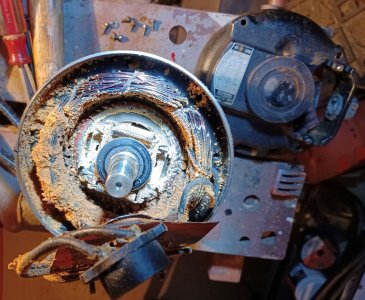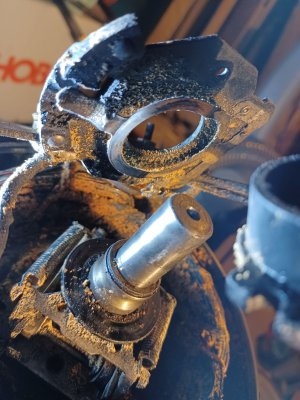- Joined
- Feb 13, 2017
- Messages
- 2,138
Measuring from any conductor to the frame: The lower the resistance, the worse the leakage. Properly done with a "megger", any resistance reading below 500K is bad. But then a megger puts out much higher voltage than an ohmmeter, usually 500 volts. Such leakage cannot usually be repaired, it must be rewound. "Dipping & Baking" such motors is a valid repair technique, but usually is not worth the cost for smaller (<25 HP) motors.
It has been my experience that an "analog" ohmmeter gives better results than does a digital. There are circumstances where a digital meter will not show voltage when it is there. A good way to commit suicide. But rare in a "home shop" environment. But then, I have always used "high end" meters, a Fluke digital and a Simpson 260 analog. Your results may vary. . .
There is a class of motors that uses different "impedance" windings to get the phase differential without using a capacitor. Usually relagated to fans and other "light" loads, larger versions can be used for machine tools. These motors will still have a centrifugal switch. There is another class of motors that I haven't seen in a long time, ca. 1970ish. It has a commutator and brushes but there is a "shorting" ring that operates at speed and the brushes are "shorted" to each other. I bring it up because your project involves old motors.
There are many "jack leg" repairs made by "less than competant" repairmen where cord insulation has been damaged. Even at low (120V) voltage, if the insulation is damaged, replace it. There are some versions of "duct tape" that contain metallic fibers. Cheaper "duck tape" usually doesn't. In any case, neither is electrical insulation.
Using compressed air to remove sawdust and other contaminants from motors does a fair job. However, use the lowest pressure possible. My preference is ~15 pounds max. Lower is better. Washing with electrical solvent once the loose trash is blown out is an option. In any case, do not use line (~100 PSI) pressure.
.
It has been my experience that an "analog" ohmmeter gives better results than does a digital. There are circumstances where a digital meter will not show voltage when it is there. A good way to commit suicide. But rare in a "home shop" environment. But then, I have always used "high end" meters, a Fluke digital and a Simpson 260 analog. Your results may vary. . .
There is a class of motors that uses different "impedance" windings to get the phase differential without using a capacitor. Usually relagated to fans and other "light" loads, larger versions can be used for machine tools. These motors will still have a centrifugal switch. There is another class of motors that I haven't seen in a long time, ca. 1970ish. It has a commutator and brushes but there is a "shorting" ring that operates at speed and the brushes are "shorted" to each other. I bring it up because your project involves old motors.
There are many "jack leg" repairs made by "less than competant" repairmen where cord insulation has been damaged. Even at low (120V) voltage, if the insulation is damaged, replace it. There are some versions of "duct tape" that contain metallic fibers. Cheaper "duck tape" usually doesn't. In any case, neither is electrical insulation.
Using compressed air to remove sawdust and other contaminants from motors does a fair job. However, use the lowest pressure possible. My preference is ~15 pounds max. Lower is better. Washing with electrical solvent once the loose trash is blown out is an option. In any case, do not use line (~100 PSI) pressure.
.


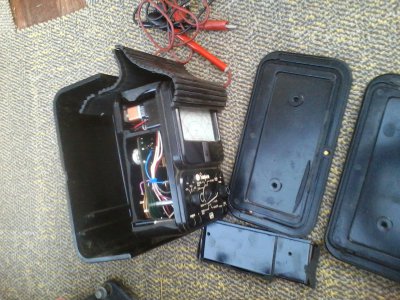
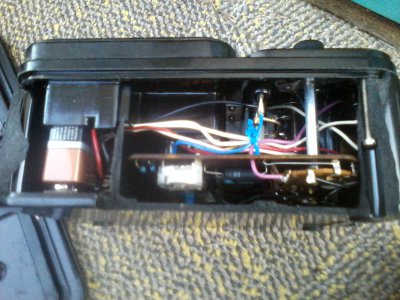
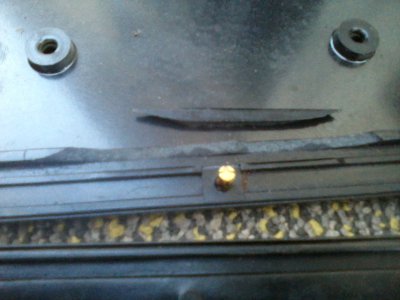
 I haven't been down my late uncle's house in years , but from what I remember , he has half of the old Crown Cork and Seal plant out in his shed .
I haven't been down my late uncle's house in years , but from what I remember , he has half of the old Crown Cork and Seal plant out in his shed .